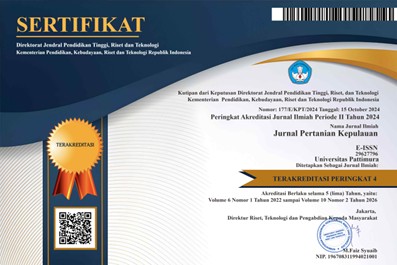Karakter Morfologi dan Morfometrik Lebah Sosial (Aphidae) di Pertanian Organik BEEMA HONEY Bogor
Abstract
Indonesia has a biodiversity of flora both from forest and agriculture that can be used as a source of bee feed. The study aims to describe the morphological and morphometric characteristics of stinged and stingless honeybees in the BEEMA Honey organic farming environment in September-December 2022. The species of stinged bees and stingless bees found to belong to the genera Apis, Tetragonula, and Heterotrigona with species Apis cerana, Tetragonula sapiens, Tetragonula biroi, Tetragonula laeviseps, Tetragonula fuscobalteata, and Heterotrigona itama. The honey bee species are found in four locations: pollinator garden, Limasan garden house, in front of the plantation house, and below the water tank. Observations of morphological characters include body color, caput, thorax, and abdomen, while morphometric characters of bees include: A. cerana; The color of the abdomen is brownish-yellow with a body length of 14.03-15.00 mm. T. sapiens; The abdomen is colored and measures 4.34-4.55 mm in length. The abdomen and tergites one to six are black. T. biroi; The color of the abdomen is black and the length of the body is 2.75-3.25 mm. T. laeviceps is black and body length is 3.0-3.2 mm. T. fuscobalteata is blackish-brown and body length is 2.33-.2.70 mm. H. itama has a dark black body with a body length of 10.66-12.25 mm.
Downloads
References
Azizi, M. G., Priawandiputra, W., & Raffiudin, R. (2020). Morphological identification of stingless bees from Belitung. IOP Conference Series: Earth and Environmental Science, 457(1). https://doi.org/10.1088/1755-1315/457/1/012011
Baja, S. M., & Mostoles, M. D. J. (2021). Stingless Bees (Hymenoptera: Apidae: Meliponini) Under Genus Tetragonula in the Philippines. AGRIKULTURA CRI Journal, 1(2).
Bleha, R., Shevtsova, T., Kružík, V., Brindza, J., & Sinica, A. (2019). Morphology, physicochemical properties and antioxidant capacity of bee pollens. Czech Journal of Food Sciences, 37(1). https://doi.org/10.17221/139/2018-CJFS
Efin, A., Atmowidi, T., & Prawasti, T. S. (2019). Short communication: Morphological characteristics and morphometric of stingless bee (Apidae: Hymenoptera) from Banten Province, Indonesia. Biodiversitas, 20(6). https://doi.org/10.13057/biodiv/d200627
Lamerkabel, J. S. A. (2011). Mengenal Jenis-Jenis Lebah Madu, Produk-Produk dan Cara Budidayanya. Jurnal Ilmu Pengetahuan Dan Teknologi, 9(1).
Lamerkabel, J. S. A., Siahaya, V. G., Saepuloh, W., Lastriyanto, A., Junus, M., Erwan, E., Batoro, J., Jaya, F., & Masyithoh, D. (2021). Karakteristik Morfologi dan Morfometrik Lebah Madu Tak Bersengat (Apidae; Melliponinae) pada Koloni di Daerah Pesisir Pulau Ambon. JURNAL BUDIDAYA PERTANIAN, 17(1). https://doi.org/10.30598/jbdp.2021.17.1.28
Li, Y. R., Wang, Z. W., Yu, Z. R., & Corlett, R. T. (2021). Species diversity, morphometrics, and nesting biology of Chinese stingless bees (Hymenoptera, Apidae, Meliponini). Apidologie, 52(6). https://doi.org/10.1007/s13592-021-00899-x
Marwaha, L. (2023). The Queen Honey Bee Morphology, Development, and Reproductive System. In The Polyandrous Queen Honey Bee: Biology and Apiculture. https://doi.org/10.2174/9789815079128112010004
Mohammad, S. M., Mahmud-Ab-Rashid, N. K., & Zawawi, N. (2021). Stingless bee-collected pollen (bee bread): Chemical and microbiology properties and health benefits. In Molecules (Vol. 26, Issue 4). https://doi.org/10.3390/molecules26040957
Purwantini, T. B., & Sunarsih, N. (2020). Pertanian Organik: Konsep, Kinerja, Prospek, dan Kendala. Forum Penelitian Agro Ekonomi, 37(2). https://doi.org/10.21082/fae.v37n2.2019.127-142
Rachma, N., & Umam, A. S. (2021). Pertanian Organik Sebagai Solusi Pertanian Berkelanjutan Di Era New Normal. Jurnal Pembelajaran Pemberdayaan Masyarakat (JP2M), 1(4). https://doi.org/10.33474/jp2m.v1i4.8716
Rozman, A. S., Hashim, N., Maringgal, B., & Abdan, K. (2022). A Comprehensive Review of Stingless Bee Products: Phytochemical Composition and Beneficial Properties of Honey, Propolis, and Pollen. In Applied Sciences (Switzerland) (Vol. 12, Issue 13). https://doi.org/10.3390/app12136370
Samsudin, S. F., Mamat, M. R., & Hazmi, I. R. (2018). Taxonomic study on selected species of stingless bee (Hymenoptera: Apidae: Meliponini) in peninsular Malaysia. Serangga, 23(2 Special Issue).
Sanjaya, V., Astiani, D., & Sisillia, L. (2019). Studi Habitat Dan Sumber Pakan Lebah Kelulut Di Kawasan Cagar Alam Gunung Nyiut Desa Pisak Kabupaten Bengkayang. JURNAL HUTAN LESTARI, 7(2). https://doi.org/10.26418/jhl.v7i2.34072
St. Clair, A. L., Zhang, G., Dolezal, A. G., O’Neal, M. E., & Toth, A. L. (2022). Agroecosystem landscape diversity shapes wild bee communities independent of managed honey bee presence. Agriculture, Ecosystems and Environment, 327. https://doi.org/10.1016/j.agee.2021.107826
Suderajat, A., Riyanto, R., & Mulawarman, M. (2021). The Types of Trigona Bee (Apidae: Meliponinae) in Three Different Habitat in South Sumatra. Jurnal Biologi Tropis, 21(1). https://doi.org/10.29303/jbt.v21i1.2461
Trianto, M., & Purwanto, H. (2020). Morphological characteristics and morphometrics of stingless bees (Hymenoptera: Meliponini) in Yogyakarta, Indonesia. Biodiversitas, 21(6). https://doi.org/10.13057/biodiv/d210633
Uyun, W., Karnan, K., & Yamin, M. (2022). The Preference of Trigona sp for pollen various plant species in Kawasan Rumah Pangan Lestari. Jurnal Biologi Tropis, 22(1). https://doi.org/10.29303/jbt.v22i1.3061





.png)


